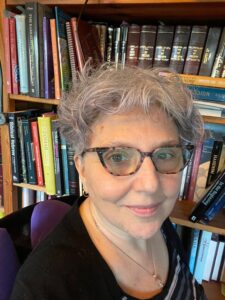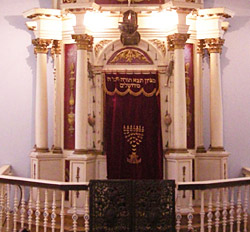
The Three Books
given the shabbat before Rosh Hashanah 5784
Tonight, we will begin Selichot, the forgiveness prayers that take us to the next level of our preparation for the days of awe. It is such a beautiful thing about Judaism that we start asking for forgiveness well before Rosh Hashanah, the day of judgment. In some way we are already forgiven before we are judged. Yet Selichot also makes us more aware that the day of judgment is quickly approaching.
One of our most vivid pictures of judgment is described in the Talmud:
“Three books are opened on Rosh Hashanah, one for the completely wicked, one for the completely righteous, and one for the intermediate ones. The completely righteous are immediately written and sealed for life, and the completely wicked are immediately written and sealed for death, the intermediate are held in suspense and stand from Rosh Hashanah til Yom Kippur. If they merit, they are written for life, and if they don’t merit, they are written for death.”
It is such a powerful and evocative image, but I’ve always had trouble fully relating to it. On a literal level, it goes counter to our rational experience, and yet I haven’t wanted to look to at it only as a metaphor. Rabbi Alan Lew, z”l in his book, This Is Real And You Are Completely Unprepared, gave us this compelling description:
… There are three immense books at the head of the sanctuary. A presence can be felt in the room so palpably you can almost see it; it hovers over the table like a colloid suspension, a smoky mist. Now you hear a deep, disembodied voice calling out names, and every time a name is called, it is written in one of the books. There is no hand, there is no quill; the pages of the book simply rustle and then quiver, and when the rustling stops, the name is already written…All of a sudden you hear your own name being called, and you want to cry out, No! No! No! Not now! I didn’t realize this was real. I thought this was just some empty ritual. I am completely unprepared. I thought it was just what came after dinner with my family. Please give me some more time. Let me do something to affect the outcome of all this. But the voice continues to intone your name and there is a rustling of the pages of the books, and your heart is gripped with terror as you wait to see in which one your name will be inscribed…
For me, this passage beautifully evokes the shock—even panic—that we might find ourselves in at this time of year. No matter what we have been doing this month, we are truly unprepared. And yet—there are still questions. For one thing, I’m pretty sure there are plenty of people who will still be alive after Yom Kippur who aren’t particularly righteous.
But one of my favorite authors, the Slonimer rebbe, Rabbi Shalom Noach Barzofsky, a 20th century rebbe in Jerusalem, in his series of books, Netivot Shalom, helped me make sense of this issue. He describes the connection between judgment and creation at Rosh Hashanah in terms of a teaching from the Ari, kabbalist Rabbi Isaac Luria of 16th century Tzfat, who taught that, as the Slonimer relates it:
…every year everything returns to its very beginning [to its starting point]; on Rosh Hashanah, Creation is renewed, and all that was created in the beginning comes into being again, for every year is a unique unit in creation (and thus each Rosh Hashanah the world is re-created).
The judgment of Rosh Hashanah, then, according to the Ari and the Slonimer, is not to dole out punishment for past wrongdoings, but rather, there is an evaluation being made as to whether or not each created being is fulfilling its role and purpose. Every individual and particular being has a unique role in creation. Otherwise, it would not have been created. Therefore at the time of the renewal of Creation, each detail is investigated; the question is asked whether this detail is needed in the coming new year. Is it fulfilling its purpose, or is it superfluous and no longer needed.
The Slonimer Rebbe cites another Chasidic Rebbe, Yaacov Yosef, who comments on this same teaching of the Ari:
He says that ‘This means that three new books are opened and every person inscribes his name in the book of his choice, for the coming year! If a person accepts upon himself to be listed among the righteous, accepting upon himself that from now on he will fulfill his destiny and purpose in this world, he is then immediately inscribed and sealed in the Book of Life, as a result of his decision.’
In this view, the ‘intermediates’ and the ‘wicked’ are those who do not accept upon themselves to fulfill their task and purpose in this world for the coming year.
For me, this teaching was incredible to find. In this reading, inscribing in the book of Life is something we do for ourselves, we who choose to take on our responsibilities, and fulfill our tasks in the world. And this commitment to the future, not some reward for what we have done in the past, is what writes us in the book of life. This teaching gives me the ability to see this process as real, and awesome, in a way I never could before. It allows me to experience the kind of immediacy that Alan Lew describes.
But Lew is also saying something more—it is not just us writing our names in the book. Sometimes things are way bigger than we imagined, and our own individual agency is smaller. Life is not just a process of free will. We really are here unprepared. But the workings of the world are not just based on determinism either—it is certainly not a case of a big guy in the sky writing our names with his quill pen, a done deal. It is an interplay. We commit to our task, but sometimes our task is bigger than we thought, or there are limiting factors beyond our control. In Lew’s image, the writing has no writer. Perhaps the author can’t be easily named. Perhaps the writing is a mutual writing, a recognition that what happens, happens because diverse aspects of the one Being, which is all there is, are mutually bringing something into Being, co-participating in the process of creation, which is renewed every year at this time, as we come around again to a place we have never been before.
So, perhaps we can hold both views. On the one hand, we cannot inscribe ourselves for life without committing to fulfill our tasks here. And I invite us to start contemplating the Slonimer’s question—are you ready to commit to fulfilling your unique tasks, your purpose in creation, from here and going forward? If so, prepare to inscribe yourself in the Book of Life.
And together with that, we can hold the knowledge that we cannot be written into the book of life without the participation of one another, and without the participation of what is much bigger even than that. Becoming conscious that our name is being inscribed in the book of life by a hand much bigger and more complex than we ever knew, opens our awareness to the reality that we are not separate individuals.
Rather, we are part of an infinite web of all-there-is-and-isn’t, and this glimpse of our interconnectedness gives us a way to more fully participate in the flow from that endless source, to help bring blessing, and life, and holy presence into this world. And this, ultimately, is the task we are all here to fulfill—serving the power of life, and the web of creation that is about to begin again. So, l’shana tova umetuka tikateivu v’techateimu—may we all be inscribed and sealed, may we all inscribe and seal ourselves, for life, and for a good and sweet new year.




 When I explore my own nature, or experience the sacred, most often I feel a deepening into darkness. Although dominating theologies create binaries, in which light is good and darkness is evil, when we recognize the multivalent nature of all that is, we see wave upon wave of dark and light.
When I explore my own nature, or experience the sacred, most often I feel a deepening into darkness. Although dominating theologies create binaries, in which light is good and darkness is evil, when we recognize the multivalent nature of all that is, we see wave upon wave of dark and light.




